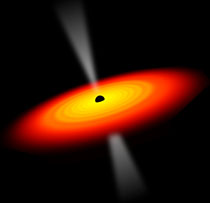

Quasars are the brightest and most distant objects in the known universe. In the early 1960's, quasars were referred to as radio stars because they were discovered to be a strong source of radio waves. In fact, the term quasar comes from the words, "quasi-stellar radio source". Today, many astronomers refer to these objects as quasi-stellar objects, or QSOs. As the resolution of our radio and optical telescopes became better, it was noticed that these were not true stars but some type of as yet unknown star-like objects. It also appeared that the radio emissions were coming from a pair of lobes surrounding these faint star-like objects. It was also discovered that these objects were located well outside our own galaxy. Quasars are very mysterious objects. Astronomers today are still not sure exactly what these objects are. What we do know about them is that they emit enormous amounts of energy. They can burn with the energy of a trillion suns. Some quasars are believed to be producing 10 to 100 times more energy than our entire galaxy. All of this energy seems to be produced in an area not much bigger than our solar system.

A pulsar is a rapidly spinning neutron star. A neutron star is the highly compacted core of a dead star, left behind in a supernova explosion. This neutron star has a powerful magnetic field. In fact, this magnetic field is about one trillion times as powerful as the magnetic field of the Earth. The magnetic field causes the neutron star to emit strong radio waves and radioactive particles from its north and south poles. These particles can include a variety of radiation, including visible light. Pulsars that emit powerful gamma rays are known as gamma ray pulsars. If the neutron star happens to be aligned so that the poles face the Earth, we see the radio waves every time one of the poles rotates into our line of sight. It is a similar effect as that of a lighthouse. As the lighthouse rotates, its light appears to a stationary observer to blink on and off. In the same way, the pulsar appears to be blinking as its rotating poles sweep past the Earth. Different pulsars pulse at different rates, depending on the size and mass of the neutron star. Sometimes a pulsar may have a binary companion. In some cases, the pulsar may begin to draw in matter from this companion. this can cause the pulsar to rotate even faster. The fastest pulsars can pulse at well over a hundred times a second.

We still do not know exactly what a quasar is. But the most recent evidence points to the possibility that quasars are produced by super massive black holes consuming matter in an acceleration disk. As the matter spins faster and faster, it heats up. The friction between all of the particles would give off enormous amounts of light other forms of radiation such as x-rays. The black hole would be devouring the equivalent mass of one Sun per year. As this matter is crushed out of existence by the black hole, enormous amounts of energy would be ejected along the black hole's north and south poles. Astronomers refer to these formations as cosmic jets. Another possible explanation for quasars is that they are very young galaxies. Since we know very little about the evolutionary process of galaxies, it is possible that quasars, as old as they are, represent a very early stage in the formation of galaxies. The energy we see may be ejected from the cores of these very young and very active galaxies. Some scientists even believe that quasars are distant points in space where new matter may be entering our universe. This would make them the opposite of black holes. But this is only conjecture. It may be some time before we really understand these strange objects.

The first identified quasar was called 3C 273 and was located in the constellation Virgo. It was discovered by T. Matthews and A. Sandage in 1960. It appeared to be associated with a 16th magnitude star like object. Three years later, in 1963, It was noticed that the object had an extremely high red shift. The true nature of this object became apparent when astronomers discovered that the intense energy was being produced in a relatively small area. Today, quasars are identified primarily by their red shift. If an object is discovered to have a very high red shift and appears to be producing vast amounts of energy, it becomes a prime candidate for quasar research. Today more than 2000 quasars have been identified. The Hubble space telescope has been a key tool in the search for these elusive objects. As technology continues to enhance our windows to the universe, we may one day fully understand these fantastic lights.
Stars | Planets | Moons | Asteroids-Comets | Nebulae | Star Clusters
Galaxies | Pulsars | Quasars | Black Holes | Dark Matter